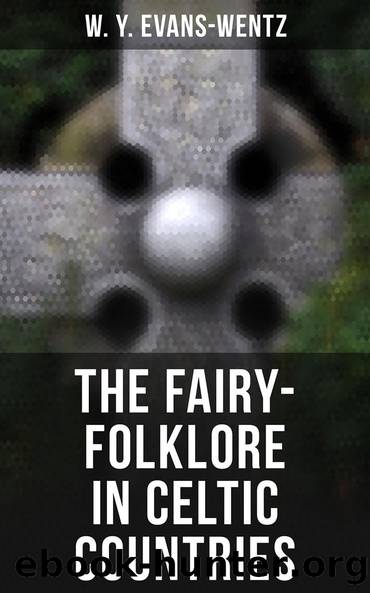The Fairy-Folklore in Celtic Countries by W. Y. Evans-Wentz

Author:W. Y. Evans-Wentz [Evans-Wentz, W. Y.]
Language: eng
Format: epub
ISBN: 9781644502242
Barnesnoble:
Publisher: 4 Horsemen Publications, Inc.
Published: 2021-04-01T00:00:00+00:00
The Palaces of the Sidhe
The marvellous palaces to which the Tuatha De Danann retired when conquered by the race of Mil were hidden in the depths of the earth, in hills, or under ridges more or less elevated.[232] At the time of their conquest, Dagda their high king made a distribution of all such palaces in his kingdom. He gave one sÃd to Lug, son of Ethne, another to Ogme; and for himself retained twoâone called Brug na Boinne, or Castle of the Boyne, because it was situated on or near the River Boyne near Tara, and the other called SÃd or Brug Maic ind Oc, which means Enchanted Palace or Castle of the Son of the Young. And this Mac ind Oc was Dagdaâs own son by the queen Boann, according to some accounts, so that as the name (Son of the Young) signifies, Dagda and Boann, both immortals, both Tuatha De Danann, were necessarily always young, never knowing the touch of disease, or decay, or old age. Not until Christianity gained its psychic triumph at Tara, through the magic of Patrick prevailing against the magic of the Druidsâwho seem to have stood at that time as mediators between the People of the Goddess Dana and the pagan Irishâdid the Tuatha De Danann lose their immortal youthfulness in the eyes of mortals and become subject to death. In the most ancient manuscripts of Ireland the pre-Christian doctrine of the immortality of the divine race âpersisted intact and without restraintâ;[233] but in the Senchus na relec or âHistory of the Cemeteriesâ, from the Leabhar na h-Uidhre, and in the Lebar gabala or âBook of the Conquestsâ, from the Book of Leinster, it was completely changed by the Christian scribes.[233]
When Dagda thus distributed the underground palaces, Mac ind Oc, or as he was otherwise called Oengus, was absent and hence forgotten. So when he returned, naturally he complained to his father, and the Brug na Boinne, the kingâs own residence, was ceded to him for a night and a day, but Oengus maintained that it was for ever. This palace was a most marvellous one: it contained three trees which always bore fruit, a vessel full of excellent drink, and two pigsâone alive and the other nicely cooked ready to eat at any time; and in this palace no one ever died.[234] In the Colloquy, Caeilte tells of a mountain containing a fairy palace which no man save Finn and six companions, Caeilte being one of these, ever entered. The Fenians, while hunting, were led thither by a fairy woman who had changed her shape to that of a fawn in order to allure them; and the night being wild and snowy they were glad to take shelter therein. Beautiful damsels and their lovers were the inhabitants of the palace; in it there was music and abundance of food and drink; and on its floor stood a chair of crystal.[235] In another fairy palace, the enchanted cave of Keshcorran, Conaran, son
Download
This site does not store any files on its server. We only index and link to content provided by other sites. Please contact the content providers to delete copyright contents if any and email us, we'll remove relevant links or contents immediately.
Cecilia; Or, Memoirs of an Heiress — Volume 1 by Fanny Burney(32029)
Cecilia; Or, Memoirs of an Heiress — Volume 3 by Fanny Burney(31441)
Cecilia; Or, Memoirs of an Heiress — Volume 2 by Fanny Burney(31391)
The Great Music City by Andrea Baker(30762)
We're Going to Need More Wine by Gabrielle Union(18613)
All the Missing Girls by Megan Miranda(14636)
Pimp by Iceberg Slim(13757)
Bombshells: Glamour Girls of a Lifetime by Sullivan Steve(13670)
Fifty Shades Freed by E L James(12892)
Talking to Strangers by Malcolm Gladwell(12836)
Norse Mythology by Gaiman Neil(12796)
For the Love of Europe by Rick Steves(11343)
Crazy Rich Asians by Kevin Kwan(8868)
Mindhunter: Inside the FBI's Elite Serial Crime Unit by John E. Douglas & Mark Olshaker(8673)
The Lost Art of Listening by Michael P. Nichols(7142)
Enlightenment Now: The Case for Reason, Science, Humanism, and Progress by Steven Pinker(6857)
The Four Agreements by Don Miguel Ruiz(6298)
Bad Blood by John Carreyrou(6260)
Weapons of Math Destruction by Cathy O'Neil(5805)
